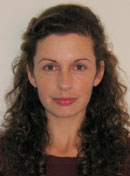Awardee Interviews | Biography: Beatriz Roldan Cuenya
Beatriz Roldan Cuenya

Beatriz Roldan Cuenya, University of Central Florida “for pioneering contributions to the understanding of processes taking place in metal nanocluster-catalyzed chemical reactions.”
Beatriz Roldan Cuenya is currently an associate professor in the Department of Physics at the University of Central Florida (UCF) with joint appointments at UCF’s Nanoscience Technology Center and the Department of Environmental Engineering. She joined UCF in 2004 after her postdoctoral research in the Department of Chemical Engineering at the University of California Santa-Barbara (UCSB) (2001-2003). She obtained her PhD from the Department of Physics at the University of Duisburg-Essen (Germany) summa cum laude in 2001. Her Ph.D included a research stay in the Materials Science Department at the Argonne National Laboratory (ANL). Beatriz completed her M.S./B.S. in Physics with a minor in Materials Science from the University of Oviedo, Spain in 1998.
Beatriz started her scientific career with an undergraduate fellowship from the Spanish National Research Council to investigate the growth of metallic thin films and multilayers via X-ray reflectometry. As a Ph.D. student in Germany (1998-2001) she studied correlations between magnetism and atomic nearest neighbor distance in epitaxial Fe films on Cu3Au(001), Fe nanostripes on Pd(110), and Fe nanoclusters and thin films on GaAs(001). These studies were conducted in ultrahigh vacuum (UHV) via Conversion Electron Mössbauer Spectroscopy and Magneto-optic Kerr effect. The existence of magneto-volume instabilities in metastable fcc-like Fe films was found to lead to dramatic changes in the Fe atomic magnetic moment as well as in the magnetic structure and exchange coupling of these systems. In addition, their reduced dimensions were found to significantly alter their magnetic anisotropy and blocking temperature.
Beatriz’s postdoctoral research at UCSB consisted of the in-situ investigation of chemically-induced electronic excitations in thin-film Schottky diodes, as well as electrochemistry measurements of the reactivity of size-selected gold clusters.
In 2004 Beatriz joined UCF to start a program exploring the novel physical and chemical properties of nanoscale materials. Her group’s scientific activities address structural, electronic, magnetic, vibrational and chemical properties of nanostructures and their interplay, with an emphasis on advancements in nanocatalysis. In order to rationally design nanocatalysts that make efficient use of energy and raw materials, fundamental knowledge of the factors that control catalytic reactivity and selectivity must be obtained. Her research tackles this challenging task by synthesizing well-defined nanomaterials with tunable morphology and composition. She has successfully combined ex-situ nanoparticle preparation methods such as diblock-copolymer micelle encapsulation with in-situ X-ray Photoelectron Spectroscopy, Scanning Tunneling Microscopy and Temperature Programmed Desorption characterization. The reactions targeted by her research group have applications in the fields of environmental remediation and power generation. Furthermore, Beatriz has developed a research program focused on the atomic vibrational dynamics of low dimensional metallic systems. These studies provide insight into important thermodynamic properties and into phonon-assisted chemical reactions that may take place on nanoclusters. She recently conducted the first vibrational dynamics measurements of isolated metal clusters (57Fe, 57FePt 57FeAu) via Nuclear Resonant Inelastic X-ray Scattering at the Advanced Photon Source at ANL.
During her academic career Beatriz received an Early CAREER Award from the National Science Foundation (2005). She is the author of 31 peer-reviewed publications and 3 book chapters and has given over 35 invited talks at international and national conferences and universities. She is also actively involved in high-school outreach activities providing research opportunities to local K-12 students. Within AVS she is serving as associate editor of the Journal of Vacuum Science and Technology B and has taught an AVS-sponsored short course on Nanophysics.